Deutschland appears to be on path to a more renewable and affordable future
A lot has been written about Germany’s energiewende or turnaround since Chancellor Angela Merkel’s government’s abrupt decision to phase out the country’s perfectly safe operating reactors by 2022 following the Fukushima nuclear disaster in Japan in 2011. The nuclear gap was to be filled by more renewables and some gas. Germany, like other European countries, is also on course to reduce its greenhouse gas emissions while increasing the overall energy efficiency of the economy as required by European Union (EU) guidelines.
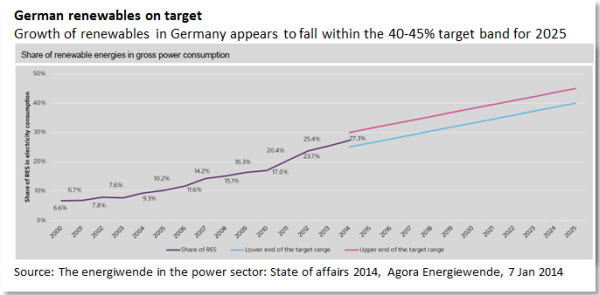
Many pundits criticized the energiewende, frequently ridiculing it as an impractical, expensive and economically ruinous gamble. It was predicted that German consumers will revolt against the rising renewable surcharges to fund the scheme, German industry will become non-competitive and the grid will collapse due to the increased intermittency and/or unpredictability of renewable generation. Indeed, there have been some ominous signs:
- Retail prices did rise even as wholesale prices were depressed;
- There were an increasing number of episodes when wholesale prices would go negative when renewable generation exceeded demand on the network;
- The 4 main grid operators had to intervene more frequently in the market to maintain grid reliability; and
- Greenhouse gas emissions rose rather than fell due to cheap coal prices.
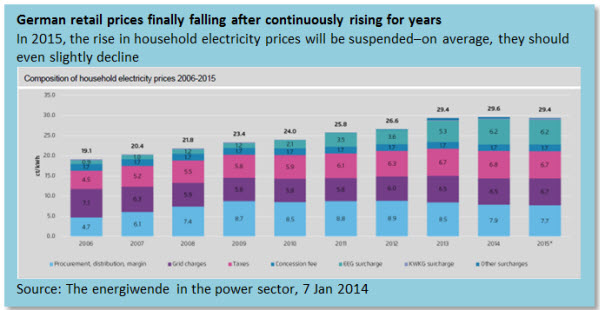
Things, however, appear to have turned around starting in 2014. According to a recent report by Agora Energiwended, Germany’s turnaround may have turned the corner heading into a brighter and greener future. At 27.3%, renewables now compromise the single largest block of generation in the German electricity mix — exceeding coal for the first time even as nuclear generation is projected to cease by 2022. There are other telltale signs that starting in 2015,
- The renewable surcharge may in fact decline a bit — ditto for retail tariffs — after continuously rising for years;
- Greenhouse gas emissions appear to have peaked and projected to decline over time — albeit not as fast or as early as many would like;
- Negative wholesale prices, while still present, are no longer rising — even as Germany has turned into a net exporter of energy due to the abundance of renewables; and
- The grid remains reliable despite frequent episodes where renewables account for 80% of all generation while on other days they are a negligible contributor – due to their inherent intermittency as well as the intermittency of load.
There are other interesting signs as well. The most significant is that overall energy consumption in Germany actually fell 4% in 2014 relative to 2013 while the economy continued to expand. Energy and economic growth, have clearly been de-coupled (graph below) – a common phenomenon observed in other mature OECD economies including the UK, the US, Australia and others.

Germany’s strong interconnections to neighboring countries, notably France, Austria and Netherlands, allows Germany’s excess renewable generation to be absorbed elsewhere — and shortages covered — a feature not applicable to many countries or regions with poor interconnections to their neighbors, say the Iberian peninsula, Italy, or Texas (map below). In 2014, Germany experienced days when renewables accounted for 80% of domestic demand. Denmark experiences the same but is small compared to Germany.
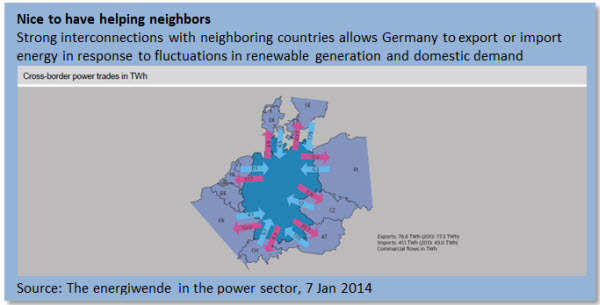
On the other extreme, there were days when renewables accounted for as little as 10% of domestic demand. Similar feats can — and are — being accommodated on other networks around the world. Large interconnected systems can indeed handle large localized variations in renewable generation.
The continued rise of renewables, of course, is not welcomed news for thermal generators, who have experienced declining wholesale prices for both baseload and peaking generation since 2008, the beginning of the global financial crisis.
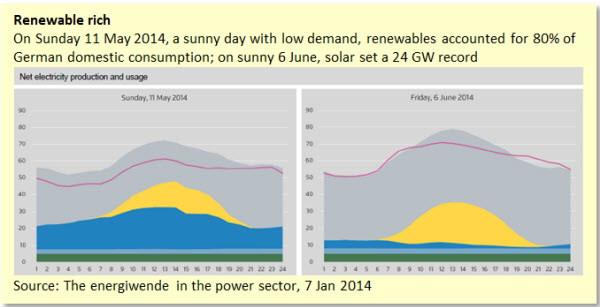
Not only do they get dispatched less frequently and for shorter hours, they receive lower prices. Making matters worse for thermal plants, the traditional mid-day peaks, which offered premium prices are all but gone especially on sunny days when solar PV generation now peaks all but wiping out mid-day peak prices.
Life has been especially hard on the 4 main German generators since 2008 with falling share prices. E.ON — the biggest German energy company — has decided to spin off its unprofitable generation business to focus on a radically new customer-centric enterprise. RWE, the second biggest, says it is shifting its focus from volume to value, whatever that means.

Germany’s greenhouse gas emissions, however, have dropped only marginally since 1990, suggesting that a lot more needs to be done if EU’s 2020 and 2030 targets are to be met.
Overall, the Agora report’s findings are welcomed news on multiple fronts. It suggests that while — at least initially — a price has to be paid to make a major transition such as that envisioned by energiewende, that it can be done. And while it takes time, one can see the light at the end of the tunnel.
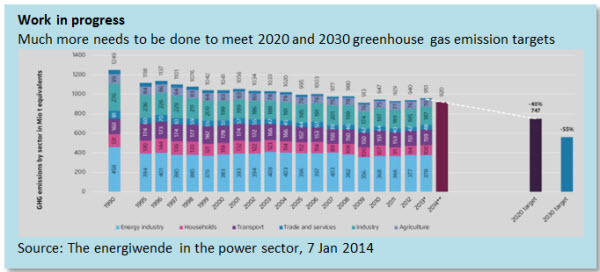
The jury is still out on the overall efficacy of the German turnaround. Two things, however, are already clear:
- Germany has shown its determination to set a target and stick to it despite the great odds and the considerable risks; and
- Through its own actions, it has single handedly contributed to rapid development and significant decline in the costs of solar PVs and on-shore and off-shore wind generation globally — from which everyone else benefits.

To download a printable (PDF) copy of this blog click here.
The contents of this blog may be reproduced, reprinted or distributed provided full attribution to EEnergy Informer Blog, 9 Feb 2015 is given. If you wish to be added to our mailing list for future stories, please send e-mail to eeinformer@aol.com with your name, affiliation & e-mail.

